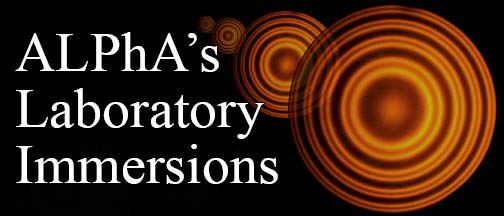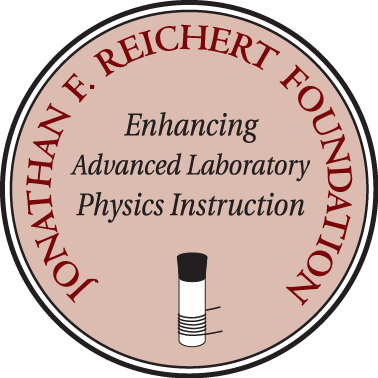- Home
- What We Do
- Laboratory Immersions
- Immersions 2024
- Imm2024UMichigan_FabryPerot
University of Michigan, Ann Arbor MI
Thin-film Fabry-Perot etalons for intermediate and advanced labs
June 3, 2024 to June 5, 2024
Number of setups available: 1
Maximum number of participants: 3
------------------------------------------------------------------------------------------------------------------------------------------
Advances in the manufacturing of Fabry-Perot etalons for a wide variety of research and industrial applications have generated affordable products that are very useful for improving experiments in intermediate and advanced physics teaching laboratories. In particular, etalons of solid media (silicon, germanium, and fused silica), with or without thin-film coatings, are now available for experiments that probe the visible and infrared regions of the electromagnetic spectrum. These solid-medium etalons are simple and robust devices that, unlike the traditional air-gap Fabry-Perot interferometers, do not require any adjustment from the student. Further, they can be purchased for less than half of the cost of an air-gap interferometer and perform very well in a laboratory teaching environment with reasonably controlled temperature.
We will present examples of classic experiments where these devices are used. Etalons thicknesses for these types of experiments range from 60 micrometers to a few millimeters and are made of fused silica with thin-film coatings.
TWO experiments will be presented:
1) Sodium D-line Splitting by Two Measurement Methods: introduces students to the splitting of atomic spectral lines due to the spin of the optically active electron in hydrogenic atoms (“fine structure”) as well as selection rules. Participants will measure the sodium D-line splitting by two independent methods: (a) using a Czerny-Turner type spectrometer; and (b) using a thin-film Fabry-Perot etalon, a cellphone camera, and the ImageJ free software. Combining the results, with proper uncertainty propagation, is a great exercise for teaching the weighted average method. Please refer to Figures 1 and 2.


|
Figure 1: Experimental setup for measurement of the Sodium D-line Splitting by two methods: a Czerny-Turner type spectrometer and using a Thin-film Fabry-Perot Etalon. |
Figure 2: Sodium D-line splitting using a Thin-film Fabry-Perot Etalon. |
2) Zeeman Effect with a thin-film Fabry-Perot etalon and a permanent magnet: introduces students to the study of the “hyperfine structure” of spectral lines, and in particular to the splitting of degenerate energy states in the presence of a strong magnetic field. It presents the students with clear evidence of LS coupling. Participants will perform measurements of both the normal and the anomalous Zeeman Effect using a cadmium vapor lamp placed in a variable-gap permanent magnet. The splitting of each spectral line is examined using a thin-film Fabry-Perot etalon and imaged by a computer-controlled camera.
Participants will:
a) Measure the strength of the magnetic field as a function of the pole separation distance.
b) Perform the normal Zeeman Effect experiment, using an appropriate bandpass filter (640 nm, 10nm FWHM), of the 643.8 nm transition (31D2 -> 21P1). Record images of the linear (perpendicular to the field) and circularly polarized (parallel) light components of the Zeeman splitting.
c) Perform the anomalous Zeeman Effect, using an appropriate bandpass filter (508 nm, 10nm FWHM), of the 508.6 nm transition (23S1 -> 23P2). Record images of the linear (perpendicular to the field) and circularly polarized (parallel) light components of the Zeeman splitting.
d) Analyze all images and measurement and compare to accepted values.
Please refer to Figure 3 and 4 below.


|
Figure 3: Apparatus for Zeeman Effect Experiment |
Figure 4: Normal Zeeman Effect in cadmium. Image perpendicular to the magnetic field. |
SCHEDULE:
Day 1
Morning: Introductions, review of Fabry-Perot interferometry, and our Czerny-Turner spectrometer.
Afternoon: Completion of experiment 1 described above.
Day 2
Morning: Discussion of the Zeeman Effect Apparatus and Theory of experiments.
Afternoon: Performance of Normal Zeeman Effect experiment; and if time allows, begin work on the anomalous Zeeman Effect.
Day 3
Morning: Completion of Anomalous Zeeman Effect.
Afternoon: Data Analysis. Lab Tours if time allows and wrap up.
COSTS
Experimental setups can range, depending on implementation, from $1,600 to $10,000 per setup. Details will be provided to participants.
SAFETY WARNING:
(1) Strong magnetic fields (near 1 Tesla) are used.
(2) Hot cadmium lamps are manually moved in and out of the magnetic fields.

Host and Mentor:
Please note that the Jonathan F. Reichert Foundation has established a grant program
to help purchase apparatus used in Laboratory Immersions. Limitations
and exclusions apply, but generally speaking the Foundation may support
up to 50% of the cost of the required equipment.




